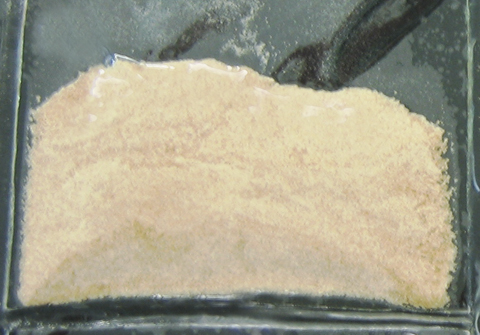-

Teknikarien eta kudeaketako eta administrazio eta zerbitzuetako langileen 2024ko LEP onartu du UPV/EHUk
-

In memoriam: Eduardo Angulo
-

11-12 urtekoek smartphoneak nagusiki hitz egiteko erabiltzen dituzte
-

Hondakin organikoak murriztearen garrantziaz DBHko ikasleak ohartzeko proiektua
-

Usteak erdia ustel, baita euskararen historian ere
The value of marine waste
The Biomat group of the University of the Basque Country uses squid, fish and algae waste to obtain new materials
- Research
First publication date: 29/09/2016

The Biomat research group of the University of the Basque Country (UPV/EHU) is upgrading the marine waste on the Basque coast (squid, fish and algae waste) to obtain new materials. This line of research is offering a fresh take on plastics aligned with the principles of the circular economy, which is based on preserving and improving natural capital by controlling finite stocks and balancing the flows of renewable resources. In this context, the group's research is highlighting, in particular, the upgrading of industrial by-products or waste through processes that minimize the use of resources, both material and energy ones, to obtain competitive, sustainable products.
"The growing concern about environmental pollution," explained Pedro Guerrero, researcher in the Department of Chemical and Environmental Engineering of the School of Engineering of Gipuzkoa and member of Biomat, "has to lead towards the development of new products based on renewable materials with a reduced environmental impact during their life cycle. European demand for plastic in 2014, according to the PlasticsEurope (2015) association, was 47.8 million tonnes, of which 90% came from non-renewable sources. Moreover, 25.8 million tonnes of plastics ended up in the rubbish, of which 30.8% completed their life cycle in landfills because this continues to be the first option for waste management in many EU countries. The alternative to this management is based on the circular economy, which, unlike the traditional linear economy, turns resources into products, products into waste, and waste into resources once again. What would be achieved in this way would be the closing of the cycle of industrial ecosystems and the minimising of the quantity of resources used, waste generated and environmental emissions However, research and innovation in this field are essential to show governments and companies that this approach is feasible. Consumer goods and plastic container companies and manufacturers of plastic products are playing a fundamental role in this initiative, because they are the ones that determine what materials and what products are put on the market".
In this context the UPV/EHU's Biomat research group is upgrading industrial waste and by-products with a view to obtaining biodegradable/compostable products with excellent in-service properties and susceptible to processing by means of techniques currently being used by the plastics industry, thus quantifying the environmental burdens involved in each of the processes carried out. In relation to the phases involved in the circular economy, Biomat is focussing its research work on improving the extraction, production and treatment processes of the product once it has been discarded in order to increase the output in these processes and cut costs and environmental impacts, thus making the development of sustainable, competitive materials possible. Right now, the Biomat group is working on a project funded by the Chartered Provincial Council of Gipuzkoa in which waste from the Basque coast is used as the raw material to obtain proteins and polysaccharides (cellulose and chitin). The field of application of these materials ranges from films for packaging to hydrogels for medical dressings.
Active containers
Within the field of containers, Biomat is immersed in obtaining active containers designed to prolong the useful life of food and, at the same time, to contribute towards reducing the amount of food discarded. "The purpose is to add value to the container, so that rather than being a mere container, it interacts with the food to maintain its quality longer. That is why fishing industry waste is being upgraded to obtain protein, chitin and cellulose by means of simple, economic, environmentally-sustainable processes and with an output close to 95%. Transparent films have been obtained from these materials for food packaging; they can be heat sealed and have excellent properties as a barrier for gases and fatty products. Furthermore, these films have been subjected to biodegradation processes with good results, so apart from upgrading by-products of the fishing industry, the material's life cycle is closed," said the researcher Guerrero.
The results of this work, in which the environmental impact associated with each of the processes involved has been determined, has been published recently in the ACS Sustainable Chemistry and Engineering journal.
Biomaterials
Apart from their application in the field of food containers, the proteins obtained can be used to produce biocompatible materials. This characteristic opens up a very broad field of application, such as biomaterials in medicine. "One of the challenges in this field," said the researcher Pedro Guerrero, "is to obtain materials that can be processed using additive manufacturing, 3D printing. 3D structures are created by continuously depositing the material, layer by layer. To do this, the first layer must have structural integrity before the second layer is deposited, and so on. Consequently, it is necessary to control the rheological parameters of the material, which must be viscous or viscoelastic initially, so that it can be turned into a gel before additional layers are deposited. Therefore, it is essential to examine not only the characteristics of the material so as to obtain a 3D structure, but also the viability of the material to be manufactured using industrial computer assisted design techniques". The results to obtain protein thread have been published in the European Polymer Journal.
Bibliographical references
Alaitz Etxabide, Itsaso Leceta, Sara Cabezudo, Pedro Guerrero, Koro de la Caba. Sustainable fish gelatin films: From food processing waste to compost. ACS Sustainable Chemistry and Engineering, 2016; 4, 4626-4634. DOI: 10.1021/acssuschemeng.6b00750
Alaitz Etxabide, Koro de la Caba, Pedro Guerrero. A novel approach to manufacture porous biocomposites using extrusion and injection moulding European Polymer Journal, 2016; 82, 324-333. DOI: 10.1016/j.eurpolymj.2016.04.001
Photo: Biomat. UPV/EHU






